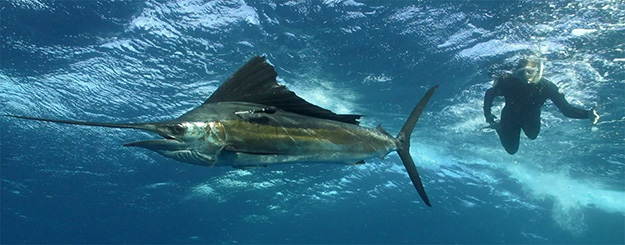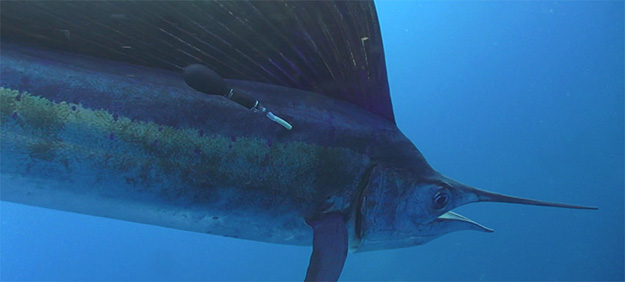RESEARCH
SAILFISH
A flock of frigate birds cruise the pre-dawn gray hunting schools of sardines forty-six miles northwest of Isla Mujeres, Mexico. Capt. Anthony Mendillo, spots the commotion and maneuvers the Keen M. towards the wheeling frigates. Thirty feet below the surface, a school of sardines mills in a tight mass. Hundreds of sailfish appear from the depths sensing the minute pressure waves of the panicked baitfish. The predator’s reaction is patient and timed. Swirling around the prey, they fan their sail-like dorsal fins to corral the baitfish toward the surface.
Capt. Mendillo notices the increased excitement among the frigate birds, a sure sign that the mass of predators and prey is moving towards the surface. A respected and successful sailfish captain, Anthony is accompanied by Dr. Molly Lutcavage of the LPRC and Dr. Guy Harvey of the Guy Harvey Ocean Foundation. Together, they hope to initiate an exploration into the migration patterns and ecological preferences of sailfish. Each fish will be outfitted with a pop-up satellite tag, a device that will allow researchers a prolonged glimpse into the habits of this species.
Below the surface the sailfish circle the sardine mass, charging through the center and picking off baits that stray to the outskirts. The predators use their bills to slash the six-inch long prey, stunning and swallowing the mangled baits. The entire attack is coordinated, not chaotic, each move communicated through a complex array of fin postures and body coloration. Before rushing the sardines each sailfish lights up, streaks of iridescent blue, gold, silver, and green flashing down its flank. They charge with fins recessed along the body, perfectly streamlined until hitting the school when their dorsal and pectoral fins snap open, scaring the sardines tighter.
The baitfish are now within reach of the surface. Frigate birds crash through the sardines looking awkward and distressed diving underwater. Caught between the sailfish and the surface, there is no chance of escape. The onslaught continues methodically until the last sardine has been consumed.

Research partner Lily Mendillo inspects the tag location on a sailfish. Photo credit: ©George Schellenger
Sailfish, Istiophorus phatypterus, are distributed throughout the tropical and temperate waters of the world’s oceans. Capable of speeds over 68 mph and reaching sizes over 200 lbs, they’re considered by sportfishermen to be one of the ultimate gamefish. Sailfish are distinguished by their protruding bill, thin body profile, and enlarged dorsal fin, which can be several times the height of the body. While there are distinct differences in the coloration, size, and life-history characteristics of geographically distinct populations of sailfish, the scientific community recognizes sailfish as a single species (I. playtypterus).
Despite the long history of sportfishing and human interaction with sailfish, many of the details of their existence remain a mystery. In a project funded by the Guy Harvey Ocean Foundation, LPRC scientists partnered with Dr. Guy Harvey and Capt. Anthony Mendillo of Keen M Sport Fishing to tag twelve sailfish with PSAT tags while fishing off Isla Mujeres, Mexico in January 2012. Through this research we hope to address many of the gaps that exist in the current knowledge of sailfish ecology. In the western Atlantic, we’re studying the reasons sailfish aggregate off the Yucatan Peninsula, and their migration patterns to and from this region. We also wish to learn how sailfish explore their habitats, what their oceanic migration patterns are, and where they spawn.
While sailfish remain the target of a thriving recreational fishery, the status of the stock is uncertain. Currently, the International Commission for the Conservation of Atlantic Tunas, the regional management body (RFMO) that manages sailfish stocks, considers sailfish to be fully exploited in the western Atlantic and overfished in the eastern Atlantic. Sailfish stocks are estimated to have declined since the 1970’s in both areas, stabilized from the 1980’s onwards in the West, and declined to a low in the 1990’s in the East. Considering the inherent uncertainly in these assessments, we hope to contribute scientific understanding that will help improve assessments, including sailfish life-history parameters and ecology so that there are healthy stocks and fisheries for the future.
Since the 1950’s, over 90,000 sailfish have been tagged with spaghetti tags in the Atlantic through the efforts of various organizations such as The Billfish Foundation and NOAA’s Southeast Fisheries Science Center’s Cooperative Tagging Center. Most tagging has occurred in the NW Atlantic, with a distribution center along the east coast of Florida. By 2008, almost 1,900 of these conventional tags had been recaptured. While the vast majority of recaptures occurred close to their release site, one sailfish traveled a minimum of over 2,391 miles from where it was released.

One of twelve sailfish tagged by LPRC scientists in January 2012. Thanks to the Guy Harvey Ocean Foundation for financial support for the research project. Photo credit: ©George Schellenger
In the Atlantic, sailfish are patchily distributed with the majority found in near-coastal waters. Unlike their close relative the blue marlin, sailfish rarely cross the Atlantic. To date, only three of the sailfish tagged in the NW Atlantic has been recaptured in the eastern Atlantic. From the data currently available, it seems that the highest concentrations of sailfish are located in three regions: 1) the NW Atlantic with high abundances in the Gulf of Mexico, Bahamas, and along the east coast of Florida, 2) off Venezuela and Brazil, and 3) off the west coast of Africa, particularly near Senegal, the Ivory Coast, the frontal zone of the Canary Current, and the Equatorial Countercurrent. While these centers of abundance are geographically separate, the levels of mixing between them are unknown. Genetic studies have not, however, found any evidence that these distribution centers represent distinct populations.
Despite the sheer number of tags released in the NW Atlantic, very little is understood about sailfish migratory and spawning habits. In the eastern equatorial Pacific and eastern Atlantic, sailfish migrate south to north, roughly following the movement of warm water masses, and the 82°F isotherm is a general predictor of sailfish seasonal movements. For example, in the NW Atlantic, sailfish travel north during summer and gather in astounding concentrations off the Yucatan peninsula in winter. In the southeastern Atlantic, sailfish migrate from foraging grounds on the northeast coast of Brazil to a spawning region off its southeast coast.
Sailfish may spawn throughout the year and over their entire range, yet there are particular areas and conditions where spawning occurs most frequently. Individuals spawn at or near the surface along eddy currents and small-scale oceanographic features that are advantageous to larval development. A single female will move sluggishly through the water with her dorsal fin fully extended, while accompanied by one or more males. Fertilization is external. Sailfish are believed to reach maturity in their third or fourth year, yet there are few exhaustive studies in Atlantic sailfish. Currently, the size at first maturity for females ranges from 58-63 in (28.5-39.7 lbs), with 50% maturity at 71 in. Males reach maturity at an earlier age and size (53 in, 22 lbs). Typically, spawning occurs during the warmest months of the year, and a single female may spawn multiple times.
Sailfish feed opportunistically on a vast array of prey species. Diet varies between different populations, but usually consists of a diverse array of fish and cephalopods. Sailfish prey includes false albacore, halfbeaks, cutlass fish, needle fish, bar jack, pin fish, neon-flying squid, and pelagic octopus. Bottom-dwelling species including sea robins and gastropods have also been found in their stomachs. Traditionally, scientists and fishermen believed that sailfish remained in the upper layers of the water column (<25-50 m). However, PSAT and archival tagging studies, along with evidence of demersal prey, indicate they sometimes dive below the thermocline to forage. While sailfish spend greater than 80% of time in the top ten-twenty meters of the water column, they can dive to over 100 m, and one tagged fish had a maximum depth record reaching 464 m. Sailfish possess specialized brain heaters and photoreceptors in the eye that are adapted feeding in lower light conditions during these dives. One of the limited factors of diving depth, however, for not only sailfish but many of the billfish, is the change in temperature. Dr. Molly Lutcavage of the LPRC along with her colleagues have shown that billfish (and also many tuna species) rarely (<1%) dive to depths where the water is 4-5oF cooler than the surface, hypothesizing that this 4-5oF change is the typical physiological and biological threshold these species can cope with.
One of the prominent issues facing sailfish stocks Atlantic-wide is the potential danger of unintended interaction with commercial fleets. While it has been illegal for a U.S. flagged vessel to retain sailfish since 1988, they continue to be encountered as bycatch by pelagic longliners, and as incidental catch in both local and commercial fisheries throughout the Atlantic. In the NW Atlantic, researchers and fishermen have focused on ways to limit interaction, as sailfish caught on longlines are thought to account for approximately one-third of fisheries-related mortality in this region. Dr. David Kerstetter of Nova Southeastern University worked closely with research partners aboard the F.V. Kristin Lee, F.V. Carol Ann, and the Sea-D in order to examine the depth preferences and interactions of sailfish with longline gear. Using PSAT tags, they found that sailfish spend the majority of time in surface waters but regularly dive below the thermocline to depths where longlines are fished, suggesting that changes in the longline depth alone may not limit sailfish bycatch. However, using similar techniques Dr. Kerstetter and Dr. John Graves of the Virginia Institute of Marine Science, found that with the use of circle hooks, 88.2% of released sailfish survived longline capture, revealing the efficacy of mandatory live release as a management strategy. Post-release survivorship is also an issue in catch and release fisheries for sailfish worldwide. Fortunately, the increased use of circle hooks by both recreational and commercial fleets has made promising advances in reducing mortalities.
Written by Bart DiFiore
